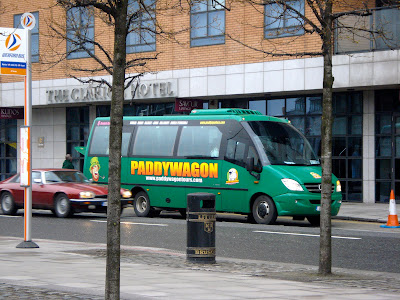One of the challenges of this project is deciding which photos to include and which ones should be left out. It is an important process not only because the selection and organization of images impacts how visually pleasing and interesting my blog will be, but also because the images suggest different understandings of Dublin as a global, cosmopolitan city (the focus of my ethnography.)
The selection of which images are "important" or "meaningful" enough to post is a kind of analysis. As Sarah Pink explains in Chapter 5 of
Doing Visual Ethnography, individual researchers classify and give meaning to ethnographic images in relation to the academic culture or discipline in which they identify their work. Since I am attempting to depict Dublin's identity as a global city, and point out the importance of urban transportation in that identity, I am obviously biased toward images that reflect that kind of globalization. On the other hand, a researcher who wanted to focus on the commute's impact on workers in Dublin (such as the
Working Lives Institute) might focus more specifically on individuals en route to a destination, whereas my research lends itself more to images of crowds or of the actual transportation structures used by them. My experience in Dublin is subjective, and therefore my archive is not representative of an objective truth, but of my impression that Dublin's identity has shifted and that globalization and transportation are linked and inherent in that process. In general, I have chosen images that I found to be visually clear and appealing when possible. I have also tried to include a sample from different types of transportation--so I try to post a balance among the different groups of photos I have in my archive. For today's entry I will include some of the originally-excluded photos to show how my decision-making process is going.
Sometimes, I have gone to areas where I expect lots of people to be moving around, and realized that I don't know the city quite well enough to know the right day or time of day to look, and have found roads and sidewalks a bit emptier than I expected.


(Approximately 9 AM, Good Friday)
I am still working on improving my photography skills, and for that reason, sometimes Dublin is just moving too quickly for me to capture a good image..



I found myself, once I had started this project, taking photographs of transportation in places other than the city of Dublin, wondering if there was a way in which they did fit the project. However, realizing that it would be extremely difficult to gain a sense of Ireland's transportation system as a whole, much less those of various cities I would be visiting, I knew it would be better to focus on Dublin and Dubliners specifically. I had to leave out certain images I liked because I recognize that they do not fit this particular project.

I actually included this in an earlier post because it includes a Dublin city bus, until I remembered that it is actually not in Dublin, but in County Wicklow.

Cars on the street in Prague, Czech Republic


Port in Barcelona (although I did find it particularly interesting to see a boat boasting an Irish flag!)

The London Underground
These types of images cannot be included in my main presentation, but hopefully help to demonstrate the process I use to decide which photos will be the best to post.






 I found this last one particularly interesting, because of the message it conveys to its (primarily bus-riding) audience about the relative worth of different means of transportation based on cost.
I found this last one particularly interesting, because of the message it conveys to its (primarily bus-riding) audience about the relative worth of different means of transportation based on cost.















